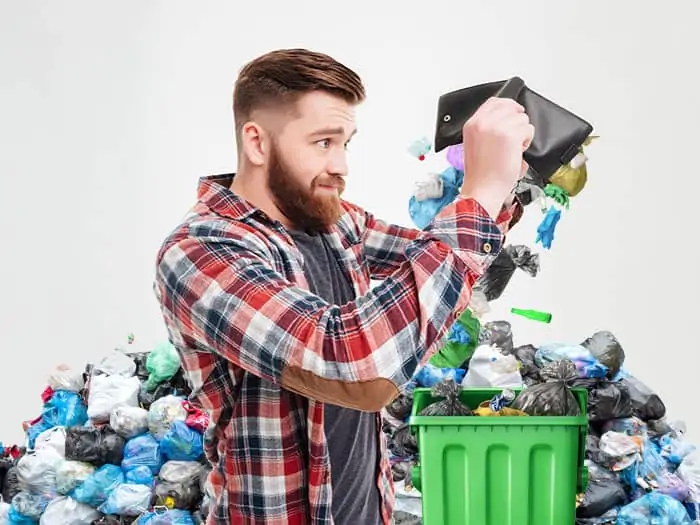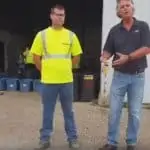

See SCS Engineers Waste Characterization Services

Recently the state of Wisconsin released its updated 2020-2021 statewide waste characterization study. The study found that the broad organics category, including yard waste and diapers, accounted for about 1.3 million tons. An estimated 924,900 tons of paper, including cardboard, compostable and office paper, comprised about 21 percent of the landfills’ tonnage. That was followed by plastic at about 17 percent or 745,600 tons.
You can read the study, but why do local governments, states, and waste management businesses request these studies? Because waste and landfills are expensive to manage. Diverting waste from landfills cuts greenhouse gases and supplies materials for reuse as new products or compost – a more sustainable system.
Waste characterization information is designed for solid waste planning; however, anyone interested in the characteristics of the solid waste stream may find it useful. Studies can also target specific waste or needs such as construction and demolition waste and business waste generators. A generator means a person, specific location, or business that creates waste.
These studies help start answering questions such as:
States, jurisdictions, citizens, and businesses can use this information as a planning tool to help meet state mandates and their goals to reduce waste and achieve the benefits of sustainable practices. Kudos to Wisconsin, Iowa, and California, several of the many states moving toward more circular waste management!
SCS Engineers, in partnership with the Wisconsin Department of Natural Resources – WDNR, is performing a waste sort to determine what’s in the trash going into Wisconsin’s landfills. During the waste audit, SCS will collect at least 200 samples of waste from 12 waste disposal sites across the state for eight weeks.
Solid waste, recycling, and diversion planners need to differentiate between the composition and sources of waste to appropriately manage recycling and diversion programs. These programs help citizens and businesses make the most out of their waste material and help control the cost of waste management.
Waste diversion can positively impact communities’ environmental health, reduce the potential for soil and water contamination, and conserve resources while reducing landfill operation costs. Municipal solid waste, called MSW, typically contains valuable materials. The cost of manufacturing using virgin materials increases, but technology creates new avenues for reusing materials formerly thrown away. The pandemic has influenced what we are consuming and where we dispose of wastes, from home or the office, influencing materials markets.
WDNR uses the waste audit data to evaluate current waste diversion programs’ effectiveness to identify and quantify additional materials that Wisconsin could divert from its landfills and serve as a baseline to measure future efforts. By comparing the new data to a previous waste composition study, WDNR can measure the impact of existing recycling and hazardous waste management programs. The comparison further helps identify waste generation trends and how the waste stream is changing.
The waste characterization study separately analyzes the waste stream generated from various sources, including residential, industrial/commercial/institutional, construction & demolition. For solid waste, recycling and diversion planners, it is vital to differentiate waste sources to target programs properly.
All of this helps make recycling more effective and identifies ways to reduce and reuse a large percentage of what is landfilled.
Many items we throw away have continued value. Cell phones and electronics contain valuable materials, like gold, for example. Cardboard is exceptionally valuable now, as citizens and businesses are taking more deliveries at home. Organics such as food and yard waste can turn into compost. Aluminum and steel cans can be recycled over and over again to make new cans. According to the Aluminum Association’s Can Committee, making a new can from recycled aluminum takes 95% less energy and releases 95% fewer greenhouse gases than creating the same can without recycled material.


The Association of Plastic Recyclers announced the development of the “APR Plastic Sorting Best Management Practices Guide,” to encourage the standardization of data collected during waste characterization studies. The Plastic Sorting BMPs are intended to help the solid waste industry better understand the different types of plastic materials in the current recycling stream for comparison, to develop trending data, and to improve the industry’s knowledge about the composition of plastic waste by expanding on the current methodology. The BMP’s do not change any categories but add clarity to the existing categories that could provide more insight because the industry is naming, dividing, and sorting consistently.
Municipalities and states regularly sort their waste and recycling streams, but there is not a consistent use of terminology and categorization used by all. The BMPs define plastic sorting categories by resin and form, with categories aligning with plastic recycling commodities traded after sorting at MRFs. The terminology aligns with annual plastic recycling tracking.
APR’s standards place plastics into five categories:
Three sorting levels provide flexibility on how extensive a study is necessary. For example, PET, HDPE natural and HDPE color are common plastic commodities nationwide; almost every recycling program is recycling the sub-categories in Level 1. While Levels 2 and 3 add more sub-categories so that the solid waste and recycling industry and municipal policies, that will always vary somewhat, will find the BMPs useful.
With the tonnage of waste increasing every year and the challenges of National Sword policies, it is more important than ever to collect data consistently to improve recovery and understand the volume of specific types of plastics to make the appropriate capital investments in infrastructure.
The solid waste industry is positioning itself to meet increased demand and enhance the quality while suppliers consider how to adapt their packaging for a future of greater recycling and reuse. Municipalities can identify more easy-to-regulate commodities for increasing commodity sales.
Quoted recently in Resource Recycling, Stacey Demers of SCS Engineers explained that standardization is a great idea to help municipalities know the percentage of recyclable plastics in their waste stream and what their program needs to target later on.
Waste characterisation studies are important tools for helping local governments and private companies make decisions on the best solid waste management programs, policies, and technologies to reduce short-lived climate pollutants. Knowing what materials comprise your waste stream will help you establish the right mix of waste diversion and energy programs to make your community more sustainable.
This webinar led by Brent Dieleman of SCS Engineers, a Senior Project Professional with the division of Sustainable Materials Management provides information on how to conduct a waste characterisation study, what data you can expect to obtain from a study, and how it can be used to make solid waste program and policy decisions. Topics of discussion during the webinar include:
We thank Abt Associates on behalf of the US Environmental Protection Agency for the CCAC Waste Initiative for sponsoring the webinar which took place on March 2, 2018, at 2:00 pm CET.
View the webinar by clicking here.

Webinar Description
A waste characterization study is an important tool for helping local governments and private companies make decisions on the best solid waste management programs, policies, and technologies to reduce short-lived climate pollutants. Knowing what materials comprise your waste stream will help you establish the right mix of waste diversion and energy programs to make your community more sustainable.
This webinar provides information on how to conduct a waste characterization study, what data you can expect to obtain from a study, and how it can be used to make solid waste program and policy decisions. Topics of discussion during the webinar include:
Webinar access:
Join WebEx meeting
Meeting number (access code): 648 518 922
Join by phone
+1-415-655-0002 US Toll
Global call-in numbers
Thank you to the United Nations Environment, Climate & Clean Air Coalition (CCAC) for sponsoring this valuable event.